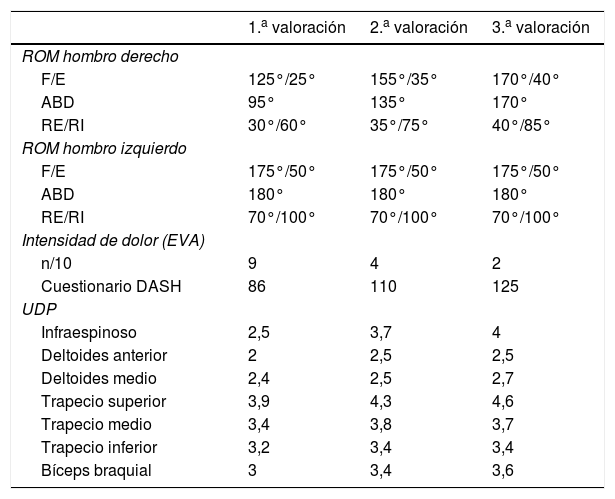El dolor de hombro, específicamente el síndrome de impingement subacromial, es un problema que afecta a gran parte de la población, siendo el segundo más frecuente después del dolor lumbar. Se han obtenido resultados beneficiosos sobre la musculatura afecta con la utilización de la punción seca profunda en el tratamiento.
ObjetivoEvaluar los cambios en intensidad de dolor (EVA), umbral de dolor a la presión (algometría), rango osteomuscular (goniometría) y funcionalidad (DASH) obtenidos con el tratamiento de punción seca profunda, combinado con liberación por presión y estiramiento local con espray frío, en un paciente con síndrome de impingement subacromial.
Descripción del casoVarón de 35 años con dolor, de 3 meses de evolución, en la cara anterior y lateral del hombro derecho que se irradia al miembro superior derecho, llegando hasta la mano y dedos.
IntervenciónSe realizan 4 sesiones de fisioterapia, con una duración de 60min cada una y una distancia temporal de 8 días entre ellas. Se evalúan las variables de intensidad del dolor, umbral del dolor a la presión, rango osteomuscular, puntos gatillo miofasciales y funcionalidad del hombro. Se exploran 9 músculos de la región del hombro para diagnosticar los puntos gatillo miofasciales existentes y tratarlos mediante técnicas de punción seca profunda, liberación por presión y estiramiento local con espray frío.
Resultados y discusiónLos resultados muestran una disminución de la intensidad del dolor, aumento del rango osteomuscular, del umbral del dolor a la presión y de la funcionalidad. Por ello, el tratamiento se considera efectivo. Sin embargo, al tratarse de un estudio de caso no se pueden extrapolar los resultados al resto de población, siendo necesarias futuras investigaciones sobre esta patología y tipo de tratamiento para conseguir mejores resultados, así como incorporar otras técnicas como el ejercicio terapéutico o la electroestimulación.
Shoulder pain, specifically subacromial impingement syndrome, is a problem that affects many people, being the second most common after low back pain. Beneficial results have been obtained on the musculature effects by using deep dry needling in the treatment.
ObjectiveTo evaluate changes in pain intensity using a visual analogue scale (VAS), pressure pain threshold (algometry), range of motion (goniometry), and functionality (DASH), obtained with the treatment of deep dry needling, combined with local pressure release and stretching with cold spray on the myofascial trigger points of the musculature involved in the shoulder area.
Case description35-year-old male patient, with pain in the anterior and lateral side of the right shoulder that radiated to the upper right limb reaching the hand and fingers, of 3 months of onset.
InterventionFour physiotherapy sessions were performed, each one lasting 60min, and spaced 8 days apart. Pain variables, pressure pain threshold, range of motion, myofascial trigger points, and shoulder functionality were evaluated. Nine muscles of the shoulder region were explored to diagnose existing trigger points and to treat them using deep dry needling techniques, local pressure release, and local stretching with cold spray.
Results and discussionThe results showed a decrease in pain intensity and an increase in range of motion, algometry values, and functionality. Therefore, deep dry needling treatment of myofascial trigger point is considered effective. However, the results cannot be generalised due to the small sample size of the study. Further studies are needed on this disorder, as well as the type of treatment to obtain better results, and to incorporate other techniques besides deep dry needling, such us therapeutic exercise or electrostimulation.
Article
Si ya tiene sus datos de acceso, clique aquí.
Si olvidó su clave de acceso puede recuperarla clicando aquí y seleccionando la opción "He olvidado mi contraseña".







